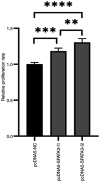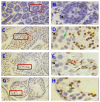Roles of human SPATA3 in cell proliferation and expression pattern of Spata3 in mouse testis
- PMID: 40641118
- PMCID: PMC12284469
- DOI: 10.3892/mmr.2025.13620
Roles of human SPATA3 in cell proliferation and expression pattern of Spata3 in mouse testis
Abstract
Male infertility predominantly manifests as abnormal spermatogenesis and maturation, abnormal semen quality, chromosomal abnormalities, and endocrine dysfunction. The present study aimed to explore the role, expression pattern and localization of spermatogenesis‑associated protein 3 (SPATA3) in the testis, and to analyze its spatiotemporal expression and function. Using previously acquired plasmids as templates, recombinant plasmids of different SPATA3 isoforms were constructed. Cell Counting Kit‑8 assay was used to analyze cell proliferation. Reverse transcription‑PCR and western blotting were used to determine the mRNA and protein expression levels, respectively. Different SPATA3 isoforms were induced to be overexpressed, among which SPATA3‑I1 and SPATA3‑I2 promoted cell proliferation. The subcellular localization results indicated that the green fluorescent protein fusion proteins of various isoforms were mainly localized in the nucleus. However, the fluorescence of the fusion proteins pEGFP‑C3‑SPATA3‑I3 and pEGFP‑C3‑SPATA3‑I4 tended to be distributed in the cytoplasm, accompanied by a decrease in nuclear fluorescence. Additionally, the SPATA3‑I2 isoform protein displayed notable tissue‑specific expression in testes. Notably, the SPATA3‑I2 isoform protein was not expressed in embryos or during the early development stage of the mice, yet it was highly expressed in the testes of mice aged 23‑57 days (3‑8 weeks). Immunohistochemistry revealed that the SPATA3‑I2 isoform protein was located mainly in round and elongated spermatids within the spermatogenic epithelial cells. In conclusion, the findings highlighted that SPATA3 isoforms had differential subcellular localizations and that SPATA3‑I2 exhibited a specific spatiotemporal expression pattern, suggesting its association with spermatogenesis and sperm maturation.
Keywords: isoforms; male infertility; spermatogenesis; spermatogenesis‑associated protein 3; subcellular localization; tissue‑specific expression.
Conflict of interest statement
The authors declare that they have no competing interests.
Figures






Similar articles
-
Semen Cuscutae-Fructus Lycii improves spermatogenic dysfunction by repairing the blood-testis barrier in rats according to in silico and in vitro methods.J Ethnopharmacol. 2021 Jun 28;274:114022. doi: 10.1016/j.jep.2021.114022. Epub 2021 Mar 16. J Ethnopharmacol. 2021. PMID: 33741439
-
lncRNA 1700009J07Rik Impaired Male Fertility by Interfering with Sexual Behaviors in Mice.Int J Mol Sci. 2025 Jun 17;26(12):5801. doi: 10.3390/ijms26125801. Int J Mol Sci. 2025. PMID: 40565260 Free PMC article.
-
PWWP3A deficiency accelerates testicular senescence in aged mice.Andrology. 2025 Jul;13(5):1236-1250. doi: 10.1111/andr.13774. Epub 2024 Oct 3. Andrology. 2025. PMID: 39363403
-
Cost-effectiveness of using prognostic information to select women with breast cancer for adjuvant systemic therapy.Health Technol Assess. 2006 Sep;10(34):iii-iv, ix-xi, 1-204. doi: 10.3310/hta10340. Health Technol Assess. 2006. PMID: 16959170
-
Home treatment for mental health problems: a systematic review.Health Technol Assess. 2001;5(15):1-139. doi: 10.3310/hta5150. Health Technol Assess. 2001. PMID: 11532236
References
-
- Rowe PJ, Comhaire FH, Hargreave B, Mahmoud AMA, editors. Cambridge University Press; Cambridge, UK: 2000. WHO Manual for the Standardized Investigation, Diagnosis and Management of the Infertile Male; p. pp91.
-
- Minhas S, Bettocchi C, Boeri L, Capogrosso P, Carvalho J, Cilesiz NC, Cocci A, Corona G, Dimitropoulos K, Gül M, et al. European association of urology guidelines on male sexual and reproductive health: 2021 update on male infertility. Eur Urol. 2021;80:603–620. doi: 10.1016/j.eururo.2021.08.014. - DOI - PubMed
MeSH terms
Substances
LinkOut - more resources
Full Text Sources
Miscellaneous

